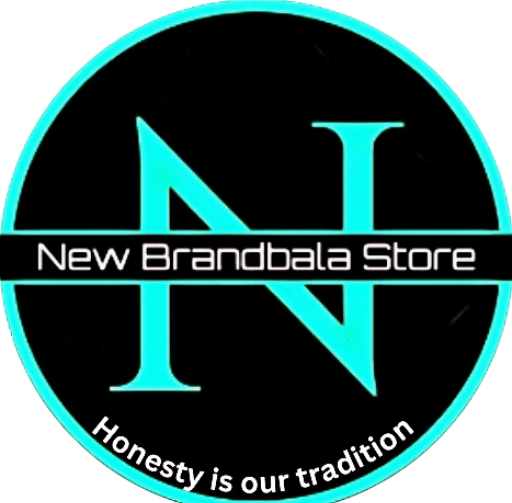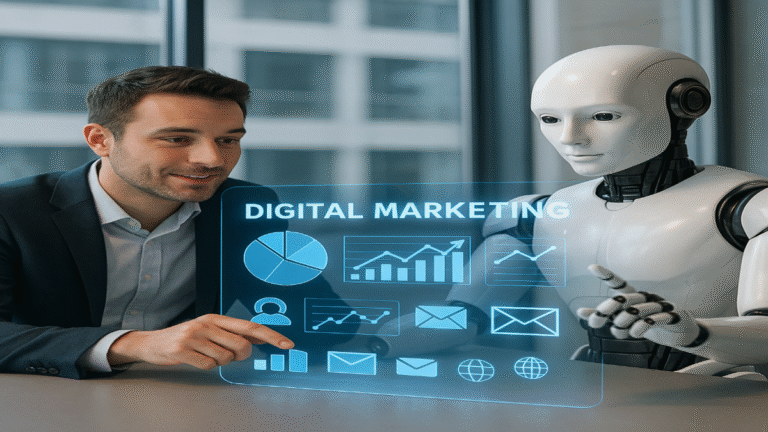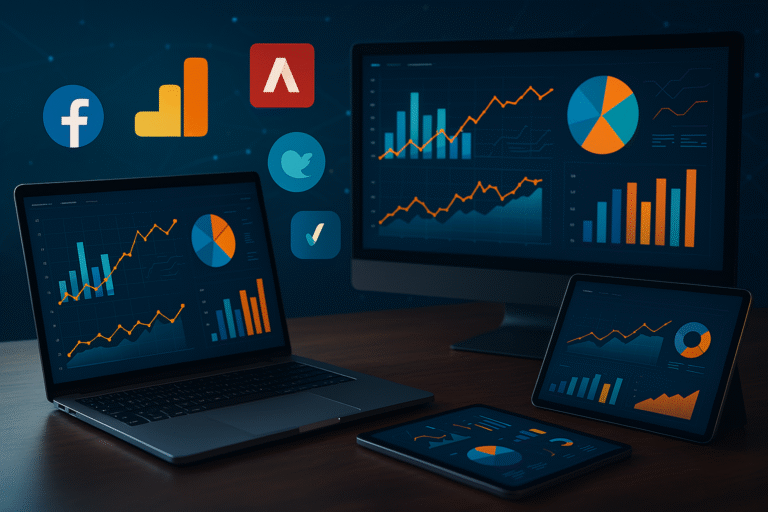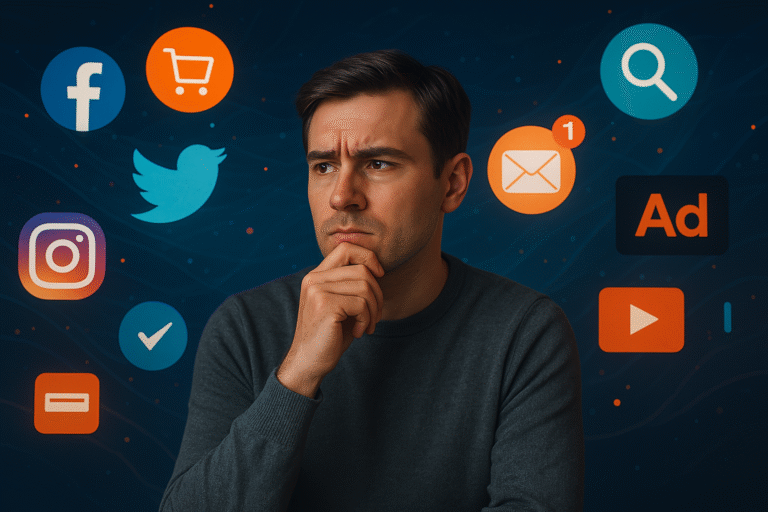In today’s fast-paced digital world, marketing has undergone a massive transformation. The rise of digital media has not only changed how businesses reach their audiences but also redefined the entire marketing landscape. From traditional methods like TV ads and print media to data-driven strategies on social platforms and search engines, the shift has been both revolutionary and inevitable.
In this article, we’ll explore in detail how digital media has reshaped every aspect of marketing — from audience targeting and brand storytelling to customer engagement and performance measurement. Whether you’re a beginner or an experienced marketer, understanding these changes will help you stay ahead in the game.
What is Digital Media?
Before diving into its impact, let’s define what digital media actually is.
Digital media refers to any form of content that is created, distributed, and consumed through electronic devices such as computers, smartphones, tablets, or smart TVs. It includes:
- Websites
- Social media platforms (Facebook, Instagram, LinkedIn, etc.)
- Video-sharing sites (YouTube, TikTok)
- Blogs and online articles
- Email newsletters
- Podcasts
- Online advertisements
These mediums have become central to modern marketing strategies because they allow for real-time communication, precise targeting, and measurable outcomes.
1. Shift from One-Way Communication to Two-Way Interaction
Traditional Marketing: A Monologue
In the past, marketing was largely one-way communication. Companies used TV, radio, newspapers, and billboards to broadcast messages to consumers. There was no immediate way for customers to respond or engage with the brand directly.
Digital Media: A Dialogue
With digital media, marketing has evolved into a two-way conversation . Brands can now interact with their audience through comments, direct messages, live chats, and reviews. This level of interaction builds trust, loyalty, and a stronger brand-consumer relationship.
Example:
A customer sees an ad on Instagram and comments asking about product features. The brand responds instantly, turning a potential lead into a loyal customer.
2. Precision Targeting Through Data Analytics
Traditional Limitations
Traditional marketing often relied on broad demographic targeting. For instance, a company might run a TV ad during a prime-time show hoping it reaches its target age group. But there was no way to know if the right people were watching.
Digital Advantage
Digital media allows marketers to use data analytics and user behavior insights to create highly targeted campaigns. Platforms like Google Ads and Facebook Ads provide tools to segment audiences based on:
- Age, gender, location
- Interests and hobbies
- Browsing history
- Purchase behavior
- Device usage
This means businesses can deliver personalized messages to the right person at the right time, increasing conversion rates and reducing wasted ad spend.
3. Cost-Effectiveness and Measurable ROI
High Costs of Traditional Methods
Traditional advertising (TV, radio, print) often requires large budgets and offers limited ways to measure effectiveness. Small businesses usually couldn’t afford these expensive channels.
Digital Media: Affordable and Trackable
Digital marketing is more cost-effective , especially for small and medium-sized businesses. Tools like SEO, content marketing, and social media marketing offer high returns without breaking the bank.
Moreover, digital campaigns are trackable in real-time . Marketers can see which ads are working, which ones aren’t, and adjust accordingly using metrics like:
- Click-through rate (CTR)
- Conversion rate
- Cost per acquisition (CPA)
- Return on investment (ROI)
Case Study Example:
A local bakery uses Facebook Ads to promote its new line of vegan cupcakes. By tracking performance daily, they optimize their budget and increase sales by 40% within a month.
4. Content is King: Storytelling and Engagement
Old-School Branding
Earlier, branding was mostly about logos, slogans, and consistent visual identity. While important, these elements lacked emotional depth and connection.
New Era: Storytelling and Authenticity
Digital media enables brands to tell stories that resonate emotionally with their audience. Whether through blog posts, YouTube videos, or Instagram reels, brands can share behind-the-scenes content, user-generated stories, and customer testimonials.
This kind of authentic storytelling builds emotional connections, making customers more likely to remember and trust the brand.
Pro Tip:
Create a content calendar that aligns your brand story with seasonal events, customer journeys, and industry trends.
5. Global Reach vs Local Focus
Geographic Limitations Before
Traditional marketing was often limited by geography. A local business could only reach people within a certain radius unless it invested in national-level advertising.
Digital Media: Borderless Marketing
With digital media, even a small business can reach a global audience. E-commerce stores, blogs, and social media pages can attract visitors from all over the world, provided the content is relevant and optimized.
At the same time, digital marketing allows for hyper-local targeting — perfect for businesses serving specific communities.
Example:
A yoga studio in Denver can use Google My Business and geo-targeted Facebook Ads to attract nearby residents interested in wellness.
6. Real-Time Adaptation and Optimization
Slow Feedback Loop in Traditional Marketing
In traditional marketing, feedback comes slowly — weeks or months after a campaign launch. If something isn’t working, it’s hard to fix until the next campaign cycle.
Agile Marketing in the Digital World
Digital media allows for real-time monitoring and optimization . Marketers can tweak headlines, images, CTAs, and targeting mid-campaign based on performance data.
This agility ensures that resources are spent efficiently and campaigns stay relevant in a rapidly changing environment.
7. Rise of Influencer Marketing
Celebrity Endorsements: The Old Way
Traditionally, brands partnered with celebrities for endorsements. These deals were expensive and didn’t always guarantee results.
Micro-Influencers and Niche Communities
Digital media gave birth to influencer marketing , where brands collaborate with individuals who have strong followings in specific niches. Micro-influencers (those with smaller but highly engaged audiences) often offer better ROI than big-name celebrities.
Why it Works:
- Trust factor: People trust recommendations from influencers they follow.
- Niche targeting: Influencers cater to specific demographics, ensuring better reach.
- Authentic content: Influencer-generated content feels more genuine than traditional ads.
8. Integration of Multiple Channels (Omni-Channel Marketing)
Siloed Campaigns in the Past
Earlier, marketing efforts were often fragmented. Each channel (TV, print, radio) operated independently, leading to inconsistent messaging.
Unified Strategy Today
Digital media allows for omni-channel marketing , where brands maintain a cohesive presence across multiple platforms — websites, social media, email, mobile apps, and more. This creates a seamless customer experience and reinforces brand recognition.
Best Practice:
Ensure that your brand voice, visuals, and messaging are consistent across all digital touchpoints.
9. The Role of User-Generated Content (UGC)
Limited Customer Involvement Before
In traditional marketing, customers were passive recipients of brand messages. There was little opportunity for them to contribute or shape the narrative.
Empowering Customers with UGC
Digital media encourages user-generated content — when customers post reviews, photos, or videos featuring a brand. This type of content serves as free promotion and increases authenticity.
Benefits of UGC:
- Builds trust through peer validation
- Increases engagement and brand loyalty
- Reduces content creation costs for brands
Example:
GoPro encourages users to share adventure videos taken with their cameras. They then feature the best submissions on their official channels, creating a community around the brand.
10. Future Trends: AI, AR, and Voice Search
Digital media continues to evolve, driven by emerging technologies. Here’s a glimpse into the future of marketing:
Artificial Intelligence (AI)
- Chatbots for instant customer service
- Predictive analytics for personalized experiences
- Automated ad bidding and targeting
Augmented Reality (AR)
- Virtual try-ons for fashion and beauty products
- Interactive product demos
- Immersive shopping experiences
Voice Search Optimization
- Optimizing content for voice queries (e.g., “Hey Siri, find me a good coffee shop near me”)
- Focusing on conversational keywords and long-tail phrases
These innovations will further blur the lines between marketing and technology, offering new ways to engage audiences.
Conclusion: Embracing the Digital Transformation
The impact of digital media on marketing is profound and irreversible. It has democratized access to global markets, empowered consumers, and given businesses powerful tools to connect, engage, and convert.
For marketers, the key takeaway is clear: adapt or be left behind. Whether you’re running a startup or managing a corporate brand, embracing digital media is no longer optional — it’s essential.
By leveraging data, building authentic relationships, and staying updated with the latest trends, you can create marketing strategies that not only reach your audience but truly resonate with them.
Final Thoughts
Digital media has transformed marketing from a one-size-fits-all approach to a dynamic, interactive, and data-driven discipline. As we move forward, the ability to adapt quickly, think creatively, and leverage technology will determine the success of marketing efforts.
If you’re just starting out in digital marketing, begin with the basics — build a website, understand SEO, learn how to use analytics, and experiment with different platforms. Over time, refine your strategy based on what works best for your audience.
Disclaimer
The information provided in this article is for educational and informational purposes only. While every effort has been made to ensure accuracy, the author does not assume responsibility for errors, omissions, or misuse of the content. Readers should consult with a qualified professional before making any marketing decisions.
Word Count : ~1,350 words
SEO Keywords Used Naturally : digital media, marketing, digital marketing, SEO, content marketing, social media, user-generated content, influencer marketing, omni-channel marketing, data analytics, conversion rate.




